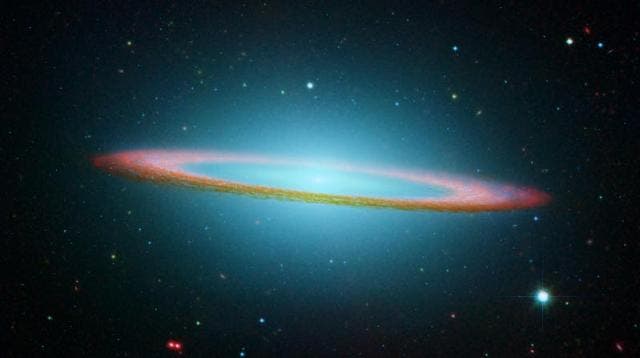
Combined visible and infrared images of the Sombrero Galaxy. Infrared: NASA/JPL-Caltech/R. Kennicutt (University of Arizona), and the SINGS Team Visible: Hubble Space Telescope/Hubble Heritage Team
Astronomers classify galaxies into three basic types: elliptical (flat, elongated shape), spiral (most easily recognizable and common – described by their disk shape and outward spiraling arms) and irregular (usually described by a irregular shape, typical to very young galaxies). One of the most fascinating galaxies known to man is the Sombrero galaxy, shaped like a hat hence it’s name. For a long time, astronomers have thought the Sombrero galaxy was a spiral galaxy; a new infrared survey by the Spitzer Telescope, however, reveals that the galaxy’s nature is more complex than previously thought. New data suggests that the Sombrero Galaxy is actually two types of galaxies in one!
So far, the galaxy has only been observed using optical telescopes, which showed it as a disk-shaped galaxy, wrapped by a beautiful glowing halo. Until recently, astronomers thought this halo was small and light, typical of spiral galaxies. Spitzer’s observations, however, which used infrared light to peer through clouds of dust and gas which obstructed previous optical observations, show that the halo around the Sombrero Galaxy is larger and more massive than previously thought, indicative of a giant elliptical galaxy. So, spiral or elliptical? The Sombrero Galaxy is both it seems.
“The Sombrero is more complex than previously thought,” says Dimitri Gadotti of the European Southern Observatory in Chile. “The only way to understand all we know about this galaxy is to think of it as two galaxies, one inside the other.”
It’s unlikely that the giant elliptical galaxy swallowed a spiral disk, as this would cause the destruction of the latter. Instead, the researchers involved in the study suggest that a giant elliptical galaxy was inundated with gas more than nine billion years ago.
“This poses all sorts of questions,” said Rubén Sánchez-Janssen from the European Southern Observatory. “How did such a large disk take shape and survive inside such a massive elliptical? How unusual is such a formation process?”
This might explain a mystery which surrounded the Sombrero Galaxies and had puzzled scientists for a while. The galaxy has over 2,000 globular clusters, when most spiral galaxies only have a few hundred – the new found two in one galaxy hypothesis seems to explain the anomaly.
The galaxy might not be alone in its “split-personality” nature. Centaurus A, appears also to be an elliptical galaxy with a disk inside it, although its disk doesn’t contain many stars.









